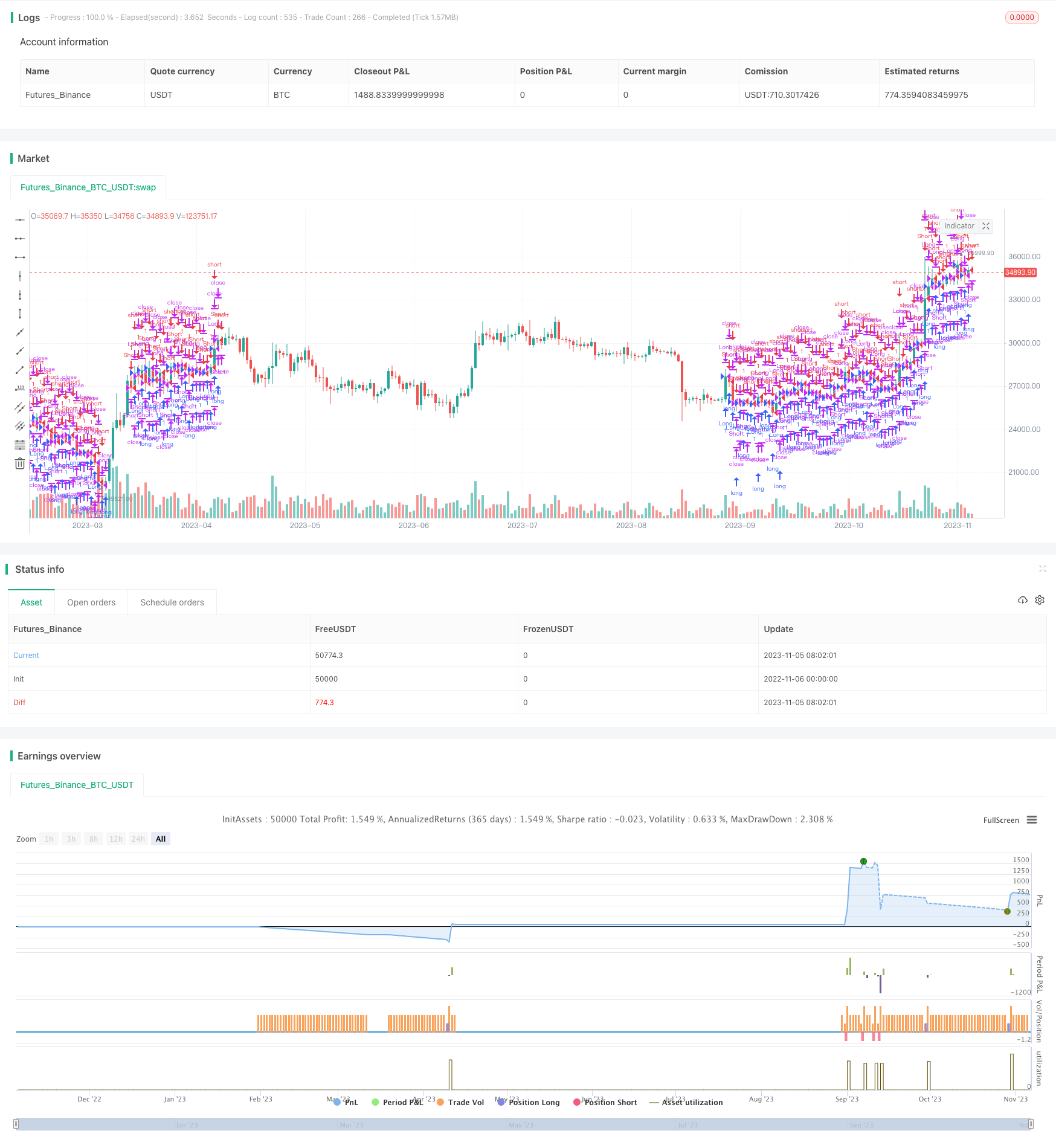
概述
本策略的核心思想是在RSI策略的基础上,加入了一些关键的交易管理规则,包括止损、止盈、追踪止损,以及杠杆追踪止损。这使得策略在回测期间能够在趋势行情中获得更高收益,同时在震荡行情中尽量减少亏损。
策略原理
该策略首先计算RSI指标,当RSI低于超买线时做多,当RSI高于超卖线时做空。
做多信号触发后,记录该时刻的最高价作为追踪止损的参考点。如果价格低于追踪止损点减去止损幅度,则止损平仓。
做空信号触发后,记录该时刻的最低价作为追踪止损的参考点。如果价格高于追踪止损点加上止损幅度,则止损平仓。
同时设置固定止盈和止损距离。如果价格达到止盈距离,则止盈清仓;如果达到止损距离,则止损清仓。
另外,根据杠杆设置杠杆追踪止损线。如果价格触及杠杆追踪止损线,则清仓止损。
通过在趋势向上时追踪最高价止损,趋势向下时追踪最低价止损,结合固定止盈止损距离,可以在趋势行情中获得更高收益。同时设置杠杆追踪止损可以尽量避免亏损扩大。
优势分析
该策略最大的优势在于引入了多个交易管理规则,在发挥RSI策略优势的同时,可以更好地控制风险。
具体来说,策略的优势有:
在趋势行情中,追踪止损可以持续跟踪趋势获利,从而获得更高收益。
固定止盈止损距离可以锁定部分利润,避免全部盈利在趋势反转时被套牢。
杠杆追踪止损可以尽量避免亏损扩大,控制风险。
多种止损方式的结合可以在不同市场环境中发挥各自的优势,整体上提高策略的稳定性。
策略参数可以灵活调整,适应不同交易品种和市场环境。
策略逻辑清晰易理解,便于验证、优化和应用。
风险分析
该策略的主要风险来源于:
RSI策略本身存在一定的错交易风险,可能出现止损被触发的情况。可以通过调整RSI参数来优化。
在止损点附近震荡可能频繁触发止损。可以适当扩大止损距离来避免。
止盈距离无法完全锁定趋势行情中的利润。可以结合其它指标判断趋势结束时机。
固定止损距离可能过小,无法完全避免亏损。可以考虑采用振荡止损或动态止损。
杠杆过高可能导致杠杆追踪止损过于靠近开仓价格。应适当降低杠杆设置。
回测时间范围无法完全代表未来市场行情。应做好风险控制,并验证不同时间段的效果。
以上风险可以通过参数调整、优化止损机制、风险控制等方式得到缓解。但任何策略都无法完全规避市场风险,需做好风险控制。
优化方向
该策略可以从以下几个方向进行进一步优化:
优化RSI参数,降低错交易概率。可以测试不同市场的最优参数组合。
尝试其他指标判断入场时机,如KD,MACD等,结合RSI形成多重过滤。
利用机器学习等方法动态优化止损止盈参数。
尝试更复杂的止损方式,如振荡止损、平均止损、动态止损等。
优化杠杆水平的设置,不同杠杆对收益和风险控制的影响。
根据市场环境变化自动调整参数,如α-Dual Thrust。
结合其它因素判断趋势持续性,如交易量能量等。
利用深度学习等技术开发更稳定和可解释的止损方式。
测试不同品种和时段的数据,评估策略的稳健性。
总结
本策略在RSI策略基础上增加多种止损方式,充分发挥止损在趋势获利和风险控制中的双重作用。策略优化空间还很大,可以从多方面入手提高策略优势并降低风险。止损策略思想普适性强,可扩展到更多策略和交易品种中,是非常值得研究的方向。通过不断优化和验证,止损策略可以成为机械交易体系中极为重要的一环。
/*backtest
start: 2022-11-06 00:00:00
end: 2023-11-06 00:00:00
period: 1d
basePeriod: 1h
exchanges: [{"eid":"Futures_Binance","currency":"BTC_USDT"}]
*/
//@version=2
strategy("Adding some essential components to a prebuilt RSI strategy", overlay=true)
/////////////// Component Code Start ///////////////
testStartYear = input(2011, "Backtest Start Year")
testStartMonth = input(8, "Backtest Start Month")
testStartDay = input(1, "Backtest Start Day")
testPeriodStart = timestamp(testStartYear,testStartMonth,testStartDay,0,0)
testStopYear = input(2016, "Backtest Stop Year")
testStopMonth = input(9, "Backtest Stop Month")
testStopDay = input(29, "Backtest Stop Day")
// testStopDay = testStartDay + 1
testPeriodStop = timestamp(testStopYear,testStopMonth,testStopDay,0,0)
// A switch to control background coloring of the test period
testPeriodBackground = input(title="Color Background?", type=bool, defval=true)
testPeriodBackgroundColor = testPeriodBackground and (time >= testPeriodStart) and (time <= testPeriodStop) ? #00FF00 : na
bgcolor(testPeriodBackgroundColor, transp=97)
testPeriod() => true
/////////////// Component Code Stop ///////////////
///////////// RSI component /////////////
length = input( 14 )
overSold = input( 30 )
overBought = input( 70 )
price = close
vrsi = rsi(price, length)
notna = not na(vrsi)
/////////////// STRATEGY ///////////////
ts = input(99999, "Trailing Stop") / 100
tp = input(99999, "Take Profit") / 100
sl = input(99999, "Stop Loss") / 100
long = notna and crossover(vrsi, overSold)
short = notna and crossunder(vrsi, overBought)
last_long = long ? time : nz(last_long[1])
last_short = short ? time : nz(last_short[1])
long_signal = crossover(last_long, last_short)
short_signal = crossover(last_short, last_long)
last_open_long_signal = long_signal ? open : nz(last_open_long_signal[1])
last_open_short_signal = short_signal ? open : nz(last_open_short_signal[1])
last_long_signal = long_signal ? time : nz(last_long_signal[1])
last_short_signal = short_signal ? time : nz(last_short_signal[1])
in_long_signal = last_long_signal > last_short_signal
in_short_signal = last_short_signal > last_long_signal
last_high = not in_long_signal ? na : in_long_signal and (na(last_high[1]) or high > nz(last_high[1])) ? high : nz(last_high[1])
last_low = not in_short_signal ? na : in_short_signal and (na(last_low[1]) or low < nz(last_low[1])) ? low : nz(last_low[1])
long_ts = not na(last_high) and high <= (last_high - ts) //and high >= last_open_long_signal
short_ts = not na(last_low) and low >= (last_low + ts) //and low <= last_open_short_signal
long_tp = high >= (last_open_long_signal + tp)
short_tp = low <= (last_open_short_signal - tp)
long_sl = low <= (last_open_long_signal - sl)
short_sl = high >= (last_open_short_signal + sl)
leverage = input(200, "Leverage")
long_call = last_open_long_signal - (0.8 + 0.2 * (1/leverage)) / leverage * last_open_long_signal
short_call = last_open_short_signal + (0.78 + 0.2 * (1/leverage)) / leverage * last_open_short_signal
long_call_signal = low <= long_call
short_call_signal = high >= short_call
if testPeriod()
strategy.entry("Long", strategy.long, when=long_signal)
strategy.entry("Short", strategy.short, when=short_signal)
// plot(long_call, color=red)
// plot(short_call, color=green)
strategy.close("Long", when=long_call_signal)
strategy.close("Short", when=short_call_signal)
strategy.close("Long", when=long_tp)
strategy.close("Short", when=short_tp)
strategy.close("Long", when=long_sl)
strategy.close("Short", when=short_sl)
strategy.close("Long", when=long_ts)
strategy.close("Short", when=short_ts)